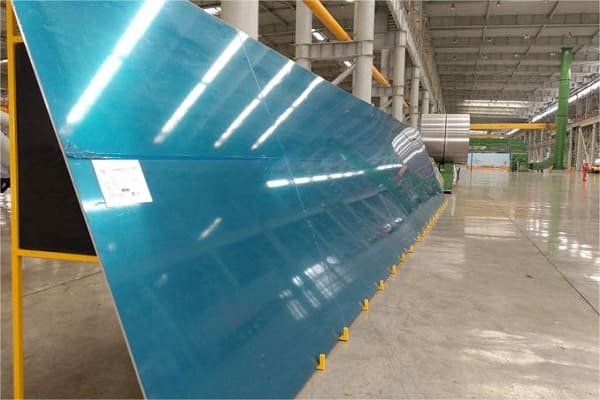O que é 5086 classe de folha de alumínio?
5086 placa de alumínio é um dos 5000 Series (5xxx series) com maior resistência à corrosão. 5086 placa de alumínio é alumínio à prova de ferrugem com alto teor de magnésio metálico. É amplamente utilizado em aplicações que exigem alta resistência à corrosão e boa soldabilidade.. situações sexuais e de intensidade moderada.
 5086 aluminum-plates
5086 aluminum-plates5086 composição química da folha de alumínio
| Liga | Mg | Zn | Mn | De | Cr | Fé | Individual | Total |
| 5086 | 3.5~4.5 | ≤0.25 | 0.20~0.7 | ≤0,15 | 0.05~0.25 | 0.000~0.500 | ≤0.05 | ≤0,15 |
Rust-proof 5086 folha de alumínio
Aluminum-magnesium alloys and aluminum-manganese alloys are collectively called anti-rust aluminum, because the alloy components between them increase their anti-corrosion properties. Representatives of aluminum-manganese alloys are 3003 folha de alumínio, 3004 folha de alumínio, e 3105 folha de alumínio. Aluminum-magnesium alloys are aluminum sheet 5005 5252 5251 5050 5052 5754 5083 5056 5086, etc. according to the content of magnesium alloy.
Folha de alumínio 5086 common thickness specifications
5086-H32 Aluminum Sheet 0.032″
5086-H32 Aluminum Sheet 0.040″
5086-H32 Aluminum Sheet 0.050″
5086-H32 Aluminum Sheet 0.063″
5086-H321 Aluminum Sheet 0.063″
5086-H116 Aluminum Sheet 0.080″
5086-H32 Aluminum Sheet 0.090″
5086-H116 Aluminum Sheet 0.100″
5086-H116 Aluminum Sheet 0.125″
5086-H32 Aluminum Sheet 0.125″
5086-H116 Aluminum Sheet 0.160″
5086-H116 Aluminum Sheet 0.190″
5086-H32 Aluminum Sheet 0.190″
5086-H116 Aluminum Plate 0.250″
5086-H116 Aluminum Plate 0.313″
5086-H116 Aluminum Plate 0.375″
5086-H32 Aluminum Plate 0.375″
5086-H116 Aluminum Plate 0.500″
5086-H32 Aluminum Plate 0.500″
5086-H116 Aluminum Plate 0.625″
5086-H32 Aluminum Plate 0.625″
5086-H116 Aluminum Plate 0.750″
5086-H116 Aluminum Plate 1.000″
5086-H116 Aluminum Plate 1.250″
5086-H116 Aluminum Plate 1.500″
5086-H116 Aluminum Plate 2.000″
5086 aluminum sheet physical properties
Densidade: 2.66 g/cm³ (0.096 lb/in³)
Ponto de fusão: 585°C to 655°C (1085°F to 1215°F)
Condutividade térmica: 125 W/(m·K) at 25°C (77°F)
Coefficient of Thermal Expansion: 23.8 x 10^-6 /°C (13.2 x 10^-6 /°F) from 20°C to 100°C (68°F to 212°F)
Specific Heat Capacity: 0.89 J/(g·°C) at 25°C (77°F)
Condutividade elétrica: 31.2% IACS (International Annealed Copper Standard) at 20°C (68°F)
Módulos de elasticidade: 68.9 GPa (10,000 ksi)
What’s the difference between aluminum sheet 5086 e 5083?
Aluminum alloys 5086 e 5083 are both marine-grade alloys known for their excellent corrosion resistance in harsh environments, especially marine applications. Contudo, there are some differences between the two, which mainly lie in their mechanical properties and composition:
composição da liga:
5086 Liga de alumínio: The main alloying element of 5086 é magnésio. It also contains small amounts of manganese, chromium and other elements.
5083 Liga de alumínio: Como 5086, 5083 is a magnesium alloy, but it also contains large amounts of chromium and trace amounts of manganese and iron.
Strength and mechanical properties:
5086: Generally slightly lower in strength than 5083, but still has good strength and excellent corrosion resistance. It is often selected for applications where weldability and corrosion resistance are critical.
5083: Comparado com 5086, it has higher tensile strength and yield strength. It is known for its exceptional strength in harsh marine environments and is commonly used in structures that require high strength, such as the shipbuilding industry.
Soldabilidade:
Both alloys are weldable, but 5086 is generally considered easier to weld than 5083. 5086 is known for its good solderability using standard soldering methods, enquanto 5083 may require more specialized soldering techniques to maintain its mechanical properties.
aplicativo:
5086: Commonly used in applications requiring moderate strength and high corrosion resistance, such as ship hulls, storage tanks and pressure vessels.
5083: Preferred in applications where higher strength and toughness are critical, such as the construction of naval vessels, cryogenic tanks and structural components.
